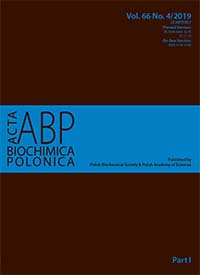The influence of a single and double biotinylation of xanthohumol on its anticancer activity
Abstract
Two biotinylated derivatives of the main hop chalcone xanthohumol (1) were prepared by a one-step synthesis via esterification using biotin and 1-ethyl-3-(3-dimethylaminopropyl)carbodiimide hydrochloride (EDC×HCl) and 4-dimethylaminopyridine (DMAP) as coupling reagents. The products were characterized spectroscopically and their antiproliferative activity toward MCF-7, MCF-10A, HepG2, MDA-MB-231, 4T1 and Balb/3T3 cell lines was investigated using the SRB assay. For all three tested compounds the best activity was noted in the case of human (MCF-7) and mice (4T1) breast cancer cell lines (IC50 values < 9 μM). Both biotinylated derivatives showed slightly higher anticancer activity than xanthohumol (1) towards all types of tested breast cancer cells. Double biotinylated xanthohumol (3) proved to be the most active in inhibiting cell growth, with IC50 values equal to 5.35 ± 1.5 μM for 4T1 and 8.03 ± 0.53 µM for MCF-7 cell lines. Compound 3 was also more active than 1 and 2 against liver cancer cells HepG2 (IC50 = 17.37 ± 5.1 μM), while the IC50 values for 1 and 2 were equal to 21.5 ± 2.7 and 22.1 ± 3.9 µM, respectively. 4‑O‑biotinylxanthohumol (2) was the second most active growth inhibitor, particularly with respect to MCF-7 (IC50 = 6.19 ± 1.7 μM) and 4T1 (IC50 = 6.64 ± 0.4 μM) cell lines. Our preliminary study on biotinylated xanthohumol (1) have shown that this type of functionalization is an effective method for the production of active biomolecules and study on this area should be continued thereby extending their applications.
Acta Biochimica Polonica is an OpenAccess quarterly and publishes four issues a year. All contents are distributed under the Creative Commons Attribution-ShareAlike 4.0 International (CC BY 4.0) license. Everybody may use the content following terms: Attribution — You must give appropriate credit, provide a link to the license, and indicate if changes were made. You may do so in any reasonable manner, but not in any way that suggests the licensor endorses you or your use.
Copyright for all published papers © stays with the authors.
Copyright for the journal: © Polish Biochemical Society.


